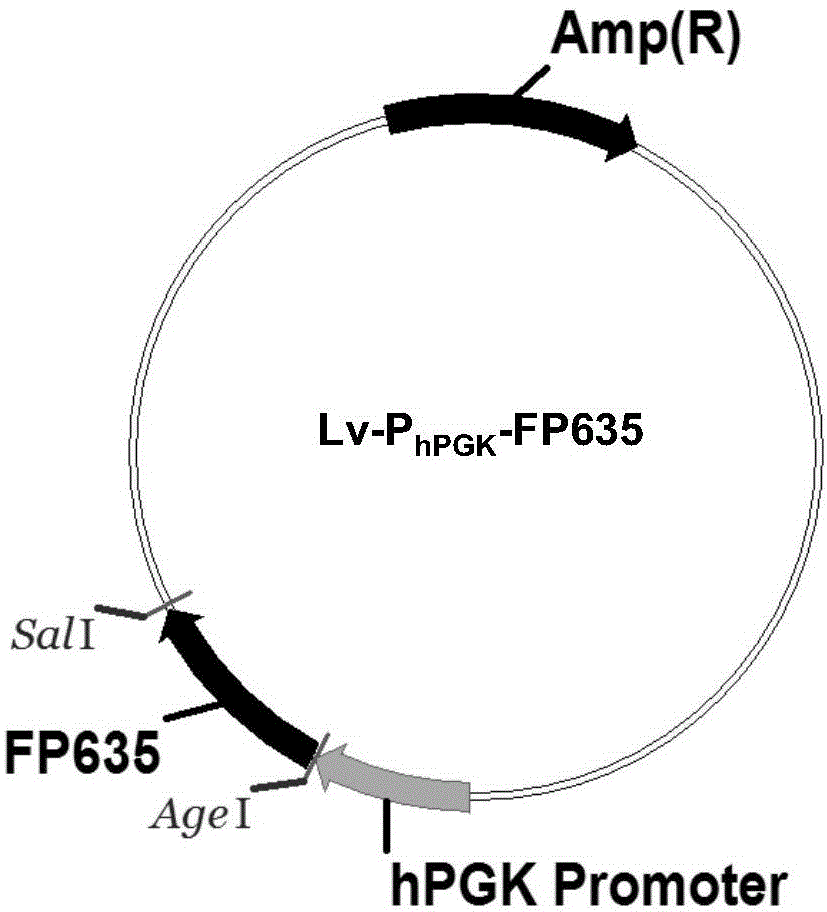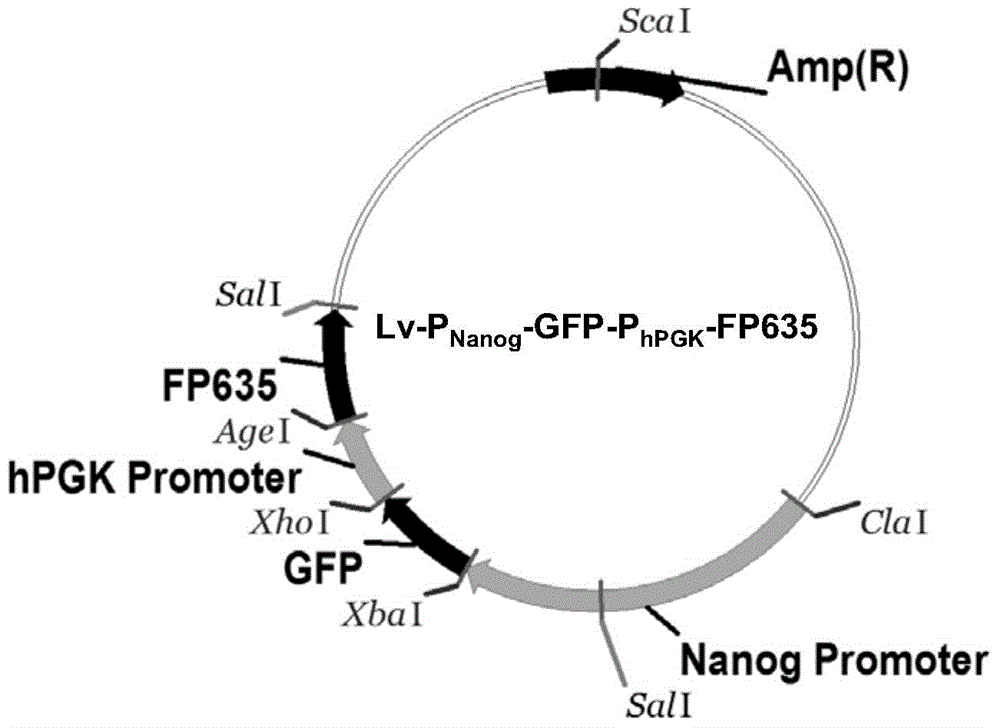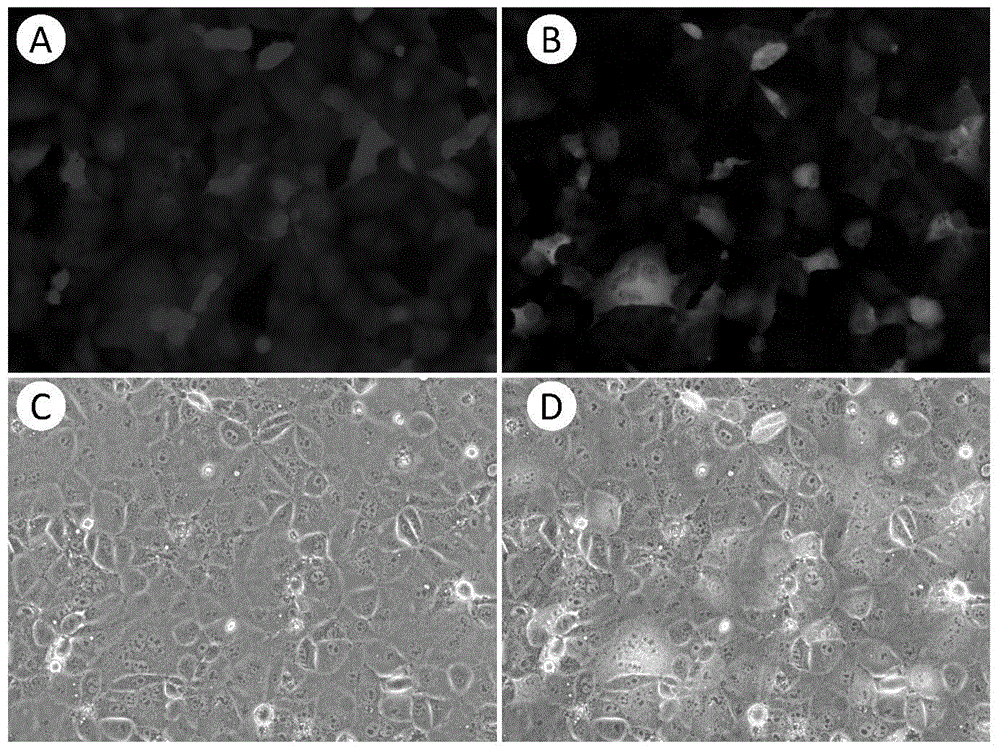Application of bifluorescence reporting system in tumor stem cell targeted drug screening and method thereof
A cancer stem cell and reporting system technology, which is applied in the application field of dual fluorescent reporter system in the screening of cancer stem cell targeted drugs, can solve the problems of affecting evaluation results, increasing system errors, and unreliable evaluation results, and improving the screening effect. Effect
- Summary
- Abstract
- Description
- Claims
- Application Information
AI Technical Summary
Problems solved by technology
Method used
Image
Examples
Embodiment 1
[0034] Example 1Lv-P hPGK -Construction of FP635 vector
[0035] In order to achieve the labeling of all experimental cells, first construct the lentiviral vector Lv-P with the promoter of the housekeeping gene PGK (phosphoglycerate kinase) expressing red fluorescent FP635 hPGK -FP635, see the structure diagram figure 1 . The build process is as follows:
[0036] 1. Construction of the intermediate vector pMD-19-T-pTurboFP635: the primers were designed with pTurboFP635-N plasmid as the template to amplify the coding region of the red fluorescent protein FP635 (SEQ ID No. 1). The primers are as follows:
[0037] 5'upstream primer: 5'-ccaccggtcg ccaccatggt gggtgaggat agcgtgctga tc-3', (SEQ ID No. 2);
[0038] 3'downstream primer: 5'-ttgtcgacgc ggccgcttta cttgtacgtc agctgtgccc cagtttgc-3', (SEQ ID No. 3).
[0039] Introduce AgeI restriction site into the 5'upstream primer, add SalI restriction site to the 3'downstream primer, and amplify by PCR. The amplification system is: pTurboFP63...
Embodiment 2
[0049] Example 2Lv-P Nanog -GFP-P hPGK -Construction of FP635 vector
[0050] Since the system described in Example 1 needs to be re-infected twice, which is relatively cumbersome, we further add Lv-P Nanog -GFP and Lv-P hPGK -FP635 The effective elements of the two viral vectors are fused into one vector (see the vector structure figure 2 ) To simplify the operation process. The build process is as follows:
[0051] 1. Construction of pMD-19-T-GFP intermediate vector: Design primers using pT-copGFP plasmid as template to amplify the coding region of green fluorescent protein GFP (SEQ ID No.5) shown in it. The primers are as follows:
[0052] 5'upstream primer: 5'-atcgattcta gacgccacca tgcccgccat g-3', (SEQ ID No. 6);
[0053] 3'downstream primer 5'-ctcgagttat caggcgaagg cgatg-3', (SEQ ID No. 7).
[0054] Introduce ClaI and XbaI restriction sites into the 5'upstream primers, add XhoI restriction sites to the 3'downstream primers, and use PCR for amplification. The amplification sy...
Embodiment 3
[0059] Example 3 GFP / RFP dual fluorescence reporter system is used for drug screening
[0060] Will be infected with Lv-P alone Nanog -GFP-P hPGK -FP635 virus or simultaneous infection with Lv-P Nanog -GFP and Lv-P hPGK -Huh7 cells of FP635 virus were plated into a 96-well plate, 1×10 per well 3 The tumor cells were cultured until the cell growth confluence reached 40-80%; different drugs and drug solvents were added as controls, and then continued to be cultured in a 37°C cell incubator; 24 hours later, the live cell dye Hoechst 33342 was added to mark the nucleus. Then immediately use the high-content imaging system to detect the expression of green fluorescent and red fluorescent protein in the well plate. After the detection, the cells can be cultured for 24h to 48h, and multiple time points of drug action can be detected separately; use the test results The MetaXpress software attached to the MD high-content imaging system performs analysis. The process is to define the n...
PUM
 Login to View More
Login to View More Abstract
Description
Claims
Application Information
 Login to View More
Login to View More - R&D
- Intellectual Property
- Life Sciences
- Materials
- Tech Scout
- Unparalleled Data Quality
- Higher Quality Content
- 60% Fewer Hallucinations
Browse by: Latest US Patents, China's latest patents, Technical Efficacy Thesaurus, Application Domain, Technology Topic, Popular Technical Reports.
© 2025 PatSnap. All rights reserved.Legal|Privacy policy|Modern Slavery Act Transparency Statement|Sitemap|About US| Contact US: help@patsnap.com



